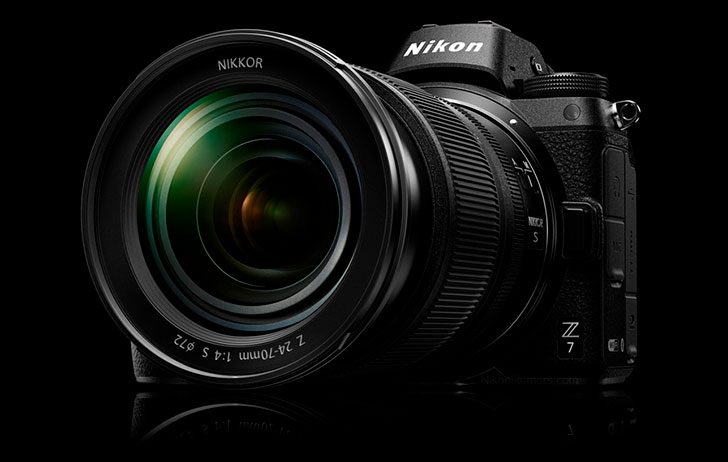Nikon will announce their full frame mirrorless cameras tomorrow, along with a slew of lenses for the system. As we're used to, the full specifications have leaked out ahead of tomorrow's announcement.
Nikon Z7 Specifications
- 45.7 MP back-illuminated CMOS
- 5 axis (sensor-based IS)
- EXPEED 6
- 64-25600
- The hybrid AF system covers about 90% of the imaging area
- 493 AF Points
- Continuous: 9 frames / sec
- 3.2″ touchscreen
- Recording medium: XQD card
- Size: 134 x 100.5 x 67.5 mm
- Weight: 675 g
- UK pricing: body:
- Body Only £3399
- Kit Lens: £3499,
- 24-70mm f/4 S kit: £3999
- 24-70mm f/4 S+ FTZ: £4099
Nikon Z6 Major Specification
- 24 MP back-illuminated CMOS
- 5 axis (sensor-based IS)
- EXPEED 6
- 100-51200
- The hybrid AF system covers about 90% of the imaging area
- 273 AF Points
- Continuous: 12 frames / sec
- 3.2″ touchscreen
- Recording medium: XQD card
- Size: 134 x 100.5 x 67.5 mm
- Weight: 675 g
Some of our articles may include affiliate links. If you purchase through these links, we may earn an affiliate commission at no extra cost to you.


Nokishita only outed the Z7's specs and it didn't have IBIS confirmed.
- A
For an IBIS newbie like me, I've certainly read the Lens IS vs. IBIS debate here, but isn't IBIS more important in mirrorless than SLRs as it helps stabilize the EVF?
- A
It looks like IBIS is more effective at shorter focal lengths. Otherwise, the new Sony telephoto wouldn't have needed image stabilization...
And Pana/Oly also have an option for IBIS with panning so I would be surprised if Nikon does not have that.
That may be the price of the new Z body + the FTZ adapter only.
And the 500mm short PF prime will cost around $3500-4000 stateside if I am reading this right -- it's just a shade over the price of the Z7 body only, which we'd guess is a ~$3300 item stateside.
- A
All the talk is on the new cameras at the moment, but I have to say, I'm quite envious of that new lens, it looks really nice and compact. And the price seems very reasonable. If Canon came out with a similar 500mm f/5.6 DO IS around that price, I'd be very, very tempted.
Mount is 55mm ID Ø. and 16mm register distance.
Yes, up to 5 stops' worth of IBIS.
I wonder if they will also move to combine IBIS with lens VR on longer FL lenses to maximize overall effect like Oly and Pany do...
Still waiting to see actual press-releases and brochures so all the features will be listed.
AF to use both phase and contrast methods
Image processor to do some sort of mid-level sharpening to improve output (hopefully just a camera jpg thing)
full HD at 120p is handy for slow-mo video.
New lenses to featured reduced focus-breathing for better video use. Also smooth and quiet focus and aperture control.
Add-on battery pack (grip or just battery case, I didn't notice) for extended shooting.
Prime lens is using a stepping motor... and designed for smoother bokeh and reduced axial CA
Lens roadmap includes more f/1.8 primes, three f/2.8 zooms (that the pros typically use)
not sure if I heard right but also some f/1.8 zooms
S-line of lenses to meet MTF and QC spec.
the 58mm f/0.95 Noct is something they're really pouring the effort into
F-mount lenses will continue to be developed
z7 available in Japan end of September, z6 end of November
adapter, 24-70/4, 35/1.8 also for end of Sept.
50/1.8 end of October.
F-mount system accessories will work (I presume things like flashes)
FTZ adapter works with about 360 compatible lenses.... that's a lot!
500/5.6 f-mount shipping mid September.
... I need the user's manual now... I really want to see what's all in this thing!
https://www.dpreview.com/reviews/nikon-z7-first-impressions-review
SINGLE CARD SLOT in a $3k+ camera. What were they thinking?
- A
- A
I would be slightly panicking were I a current Nikon F mount SLR owner. That adaptor had better sing.
- A
I'd have to say 12 FPS at 24 MP is a very attractive combination. After long use of a 5DSR I'd conclude 50MP is overkill -useful for superlarge prints but awkward file sizes otherwise. 24MP is a sweet spot for details and ease of use. Anyway well done Nikon - I hope it lives up to its promise and keeps my Nikonite friends happy. I await the Canon response with eager anticipation hoping to be reasonably satisfied.